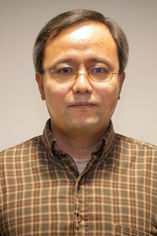According to the there are 623,405 people living with metastatic breast, prostate, lung, colorectal or bladder cancer or metastatic melanoma in the United States, and that number is expected to increase to 693,452 by the year 2025. With the estimated number of cases on the rise, now is the time to stop this disease in its tracks. Professors at şÚÁĎÍř are trying to do just that.

Hanbin Mao, Ph.D., professor, and Yaorong Zheng, Ph.D., associate professor, both of chemistry and biochemistry, and Yuki Suzuki, Ph.D., at Mie University in Japan, are conducting research on the mechanical modulation of cell migrations using DNA nanoassemblies.
While it might seem odd to see the word “mechanical” in the context of biology, Mao said this term is a universal property for almost everything, including people.

Mechanical properties influence a material’s reaction to applied forces.
“Look at a bigger scale with humans or animals, all the actions they’re doing are mechanical. With humans, we speak and there’s muscle that is functioning there,” Mao said. “At the cellular level, there are a lot of mechanical processes. Cells will migrate and that migration is essentially what causes a cut on the skin to heal.”
Mao’s work focuses on cancer biology, in particular, metastatic cancer and discovering how cancer spreads and evolves inside human bodies.
“Inside the body of a cancer cell or cancer-causing cell, you’ll see that the cell has this migration motion involved,” Mao said. “When the cancer first develops as a colony, it wants to spread out, which involves migration.”
To help fund his research, Mao has been awarded a $341,588 National Institute of Health (NIH) Research Project Grant (R01).
The research team is trying to modulate — or control and influence — these processes/motions of the cell using DNA nanoassemblies.
“The cancer has to migrate out. We want to find out how they’re doing this using a very, very tiny DNA nanoassembly,” Mao said. “After researching, I found that cancer cell migration is in the area where we can use a mechanical approach to modulate that.”
Currently, the research is targeting metastatic cancer. These cancer colonies spread out to other tissues or organs.
“I started to think about how we might be able to apply this technology into more practical settings,” Mao said. “More importantly, we want to also seek the opportunity and probability that we may stop this movement and spread of cancer in human bodies.”
This research will continue for the next five years. Mao and his team will be diligently working to learn more about cancer cells and how they travel through the human body in hopes of discovering how to halt the upward trend of those who are affected by this disease every year.
For more information about this research community, please visit Kent State’s Department of Chemistry and Biochemistry.

